REGIONAL FUTURES RESIDENCY: MID NORTH COAST NSW
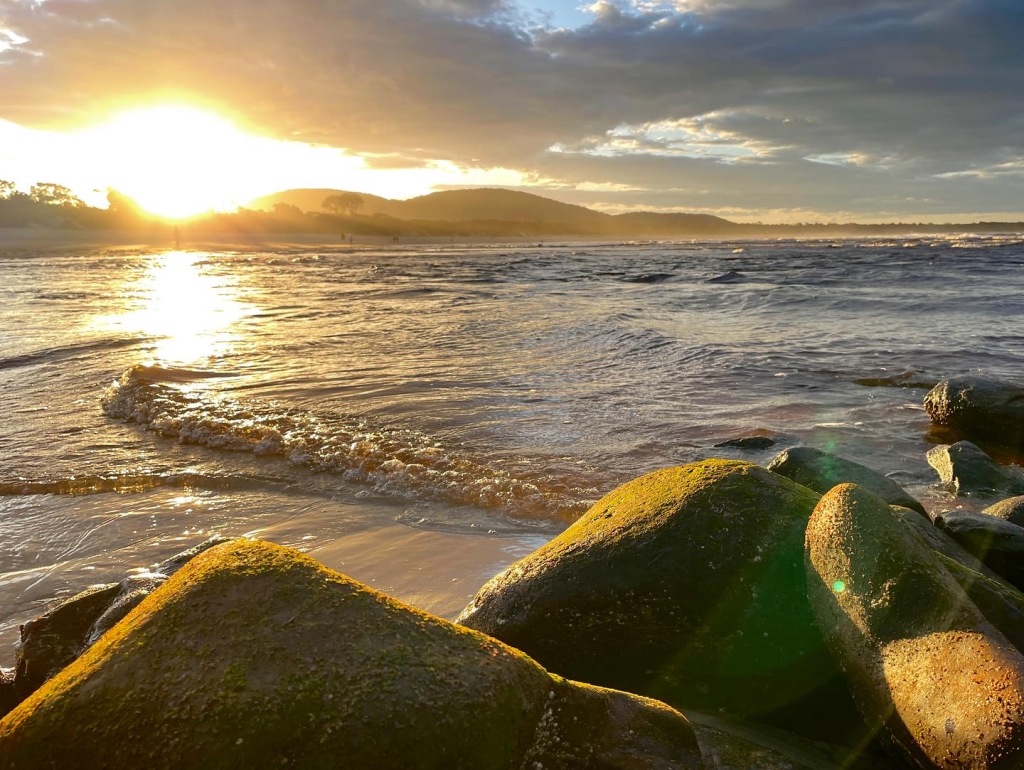
Foreign land
Fellow artist and friend, Anna Glynn, often talks about the first 48 hours of an artist residency as being time to see everything with ‘new eyes’, a period in which to experience things for the first time. It’s an opportunity to use the ‘outsider’s lens’.
When I headed to the Mid North Coast in mid-July, it was the first time in 30 years that I’d travelled this part of NSW. Much has changed in three decades, with towns along the route now bypassed by the Pacific Highway — towns considered ‘pinch points’ by the NSW Government. You don’t really get a sense of the landscape until you exit the dual lane highway. Surrounded by trees on both sides, it felt like being in a foreign land with no horizon to orientate me.
This four-day tour was part two of my Regional Futures self-directed residency, and part of a cross-region conversation between NSW regional arts development organisations (RADO), Orana Arts and Arts Mid North Coast. Four days is a short period to get a feel for the issues and communities of the region, but a full itinerary and time with fellow Regional Futures artists, Ronnie Grammatica and Kit Kelen, made the most of it.
My travelling companion was Orana Arts’ Executive Director, Alicia Leggett, who was using the trip to further the RADO relationship with Arts Mid North Coast and learn more about the independent community museum sector of the region—an area of project development for Orana Arts.
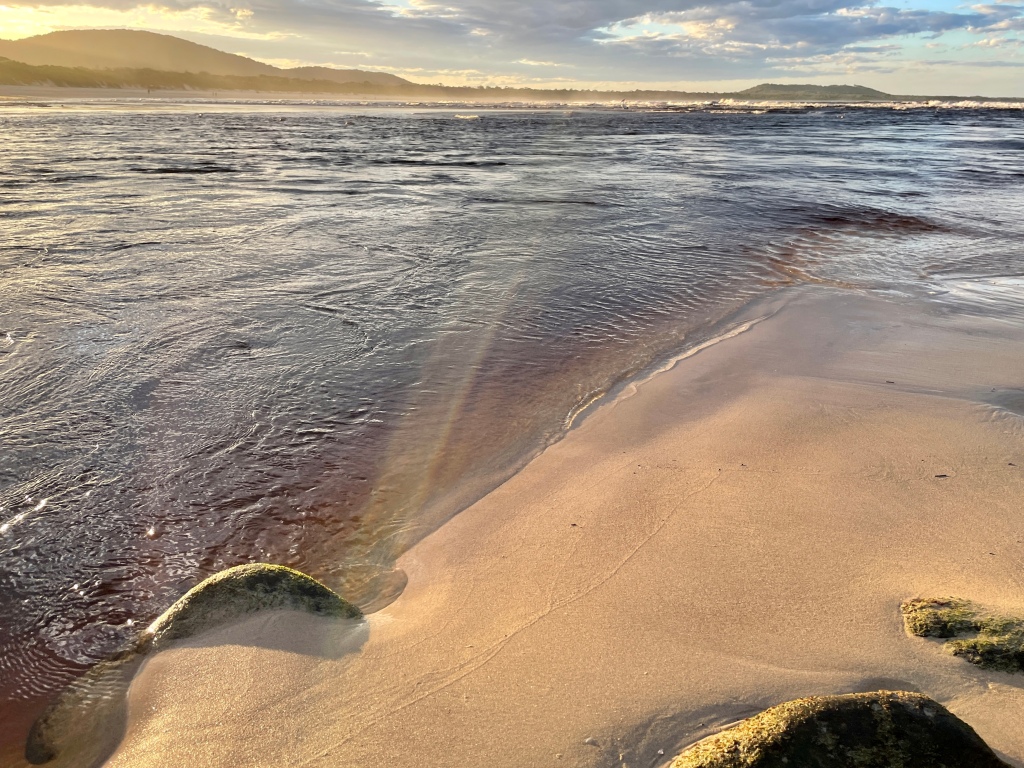
Arriving at Kempsey mid Sunday afternoon, after nine hours in the car, we had time to get to Crescent Head before the setting sun cast golden light across the waves. Ronnie runs an Italian restaurant from the local Crescent Head Surf Club and it was a wonderful treat to have dinner there with elevated views of the beach and water. It set things up for the following day.
After a restless night—I don’t do traffic noise and barking dogs, we met Ronnie at the local museum complex in Kempsey, in the Dunghutti-Ngaku Aboriginal Art Gallery. We also met arts consultant and Projects and Programs Manager from Arts Mid North Coast, Olivia Parker, and local artist Nick Warfield, who were going to show Alicia around the area.
Listening for the layers
Ronnie and I headed back to Crescent Head to talk more about the collaborative portrait/sound work that’s been brewing between us since the weekend at Wellington Caves at the end of May. We talked in the car and on the uphill walk to Big Hill Point, where we looked down from a grassy cliff face to the Pacific Ocean waves crashing below us, while birds calling unseen in the wind-swept vegetation around us. Facing the water, eyes closed, I listened for the layers of sound I have become so familiar experiencing — waves, wind, birdsong, my breath, talking through it to share the experience of listening with Ronnie. I took a few minutes to grab a recording with the shotgun mic before we headed back to town for lunch and the afternoon’s meetings.

A past, familiar life
The highlight of Monday was driving to the Goolawah Co-operative south of Crescent Head to meet a couple who have made a life there with their young family. It was after 3pm when we arrived and soft winter afternoon sunlight flickered through giant trees marked and scarred by fire, ankles cloaked in ferns. Loud, clear birdsong reverberated around us as we sat in a clearing surrounded by chickens, fruit trees, and various built structures, talking over Masala tea and apple cake. It was seemingly idyllic—and interestingly the word ‘Goolawah’ means ‘yesterday’ in the Dunghutti language. It had the feel of a past, familiar life.
Established in 2000, the Co-op is off the grid, and member houses rely on solar energy, rainwater and the use of composting toilets. They grow much of their food and participate in community activities as time permits, including helping each other build their houses. It’s described as a life of self-efficiency rather than self-sufficiency. It struck me as a very different conversation about the future than those I’ve been having in my home region albeit with the same paradoxical tension.
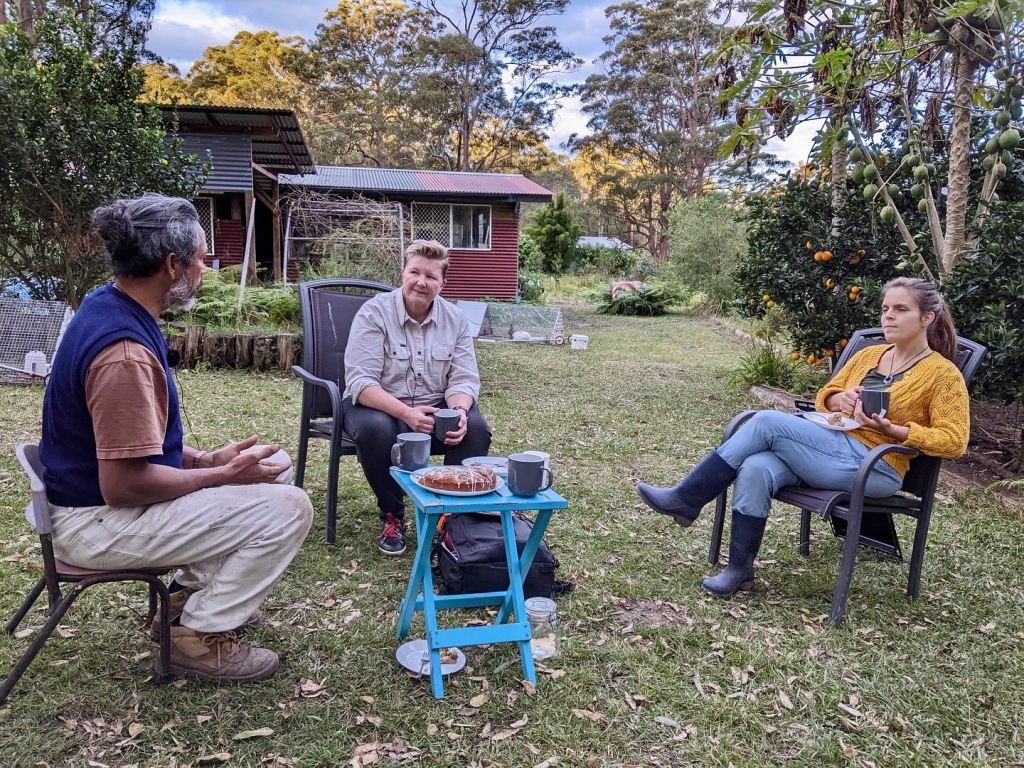
Alicia and I headed to Taree the next day, where we were meeting with Director of Manning Regional Art Gallery, Rachel Piercy. The Archibald Prize had just opened at the gallery and it was busy. A long and engaging conversation with Rachel left me feeling we were on the same page.
After a seafood lunch in town, we headed to Old Bar to spend time on the beach. I was keen to get more field recordings than I’d managed the previous day. I used my hydrophone and LOM geofón to play with the sounds of water moving through the sand, sea foam, and the movement of the tide. Rocks and interesting pieces of driftwood litter the beach at Old Bar, so Alicia had plenty to occupy herself with as I lost myself in the sonic world of the beach — including the challenge of capturing something more than just the white noise of waves.
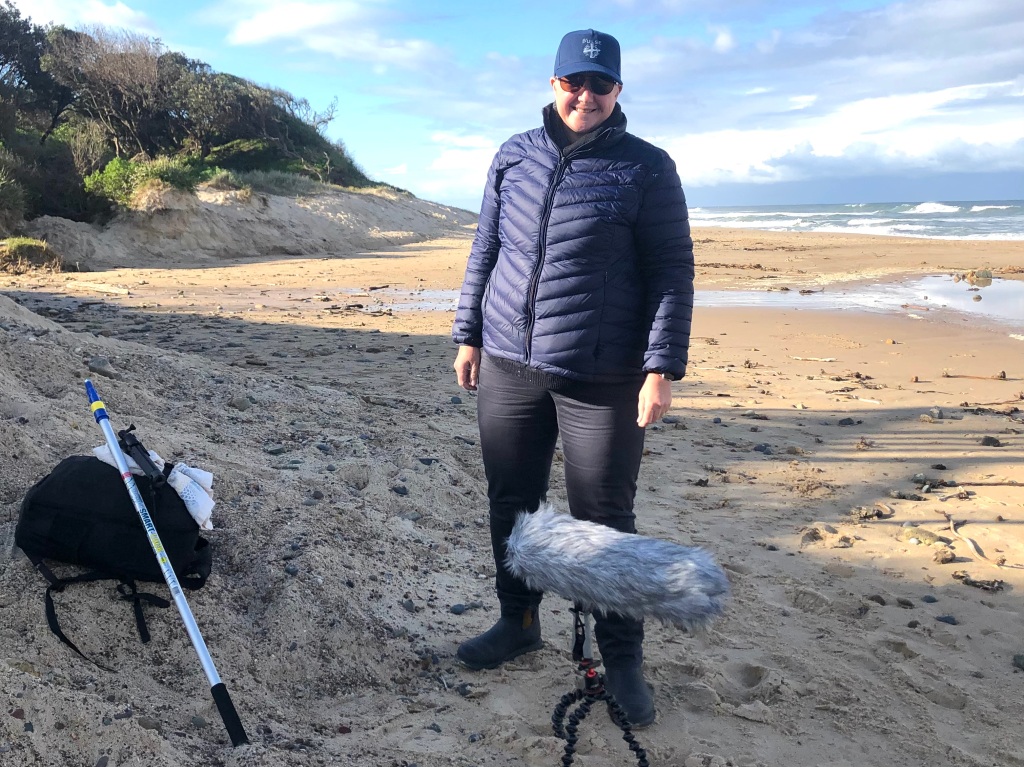
Change doesn’t stop
When my Wednesday morning meeting in Bulahdelah fell through it created an opportunity to drive the few kilometres inland from Taree to Wingham, something that had been recommended by several people in Taree. Wingham Museum is one of the very active volunteer-run museums in the region, of which there are many. It didn’t disappoint. There was so much to see and we barely scratched the surface in the hour we were there. I was particularly taken by the natural history exhibits, in particular the ‘egg drawers’. And there’s nothing quite like visiting a museum to know that change doesn’t stop.
We wandered the main street of Wingham over the next hour, learning more about the area from conversations had with locals we encountered. The other insight we gained into the area was reading a copy of the local free community newspaper, The Manning Community News…quite unlike any mainstream newspaper.
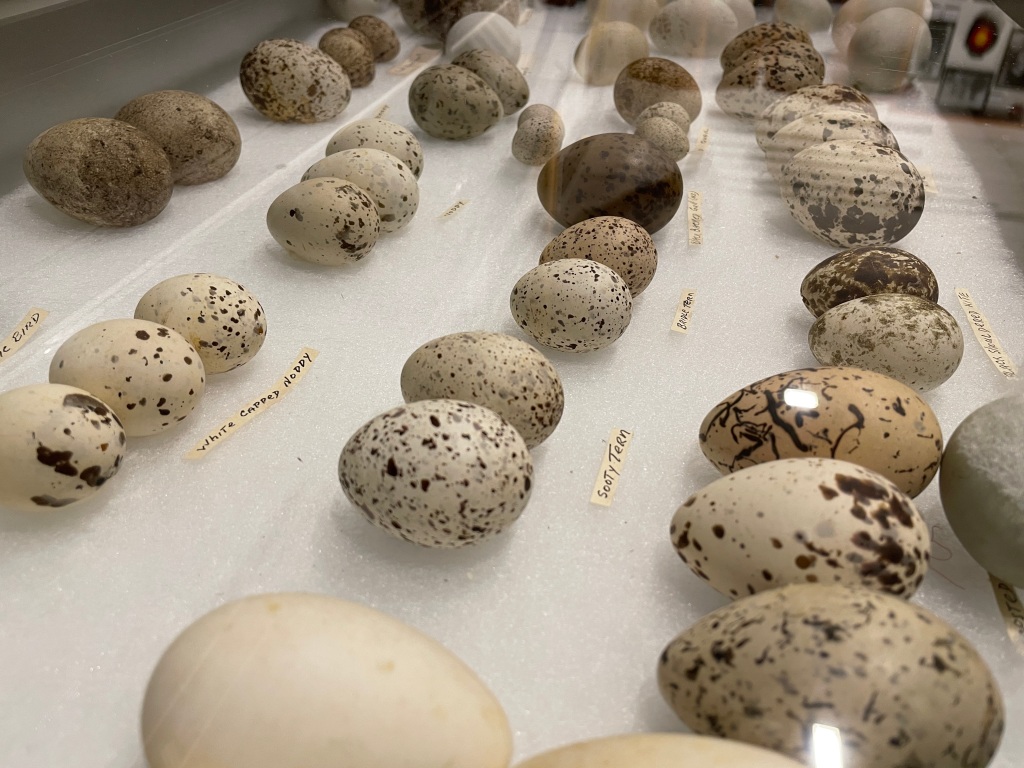
Marked landscapes
Final stop on this whirlwind tour of the Mid North Coast was Bulahdelah, where we were invited to spend the afternoon and evening with fellow Regional Futures artist/writer, Kit Kelen, and his partner, Carol Archer. I recently worked with Carol on the Inhalare project. After checking into our third motel for the week, we drove out to Markwell through open dairy and horse paddocks, the road meandering north with the Myall River State Forest on our left and the Myall River to the east. It was a short, picturesque drive marked by reminders that ‘soft’ landscapes like this are not immune to the vagaries of a changing climate.
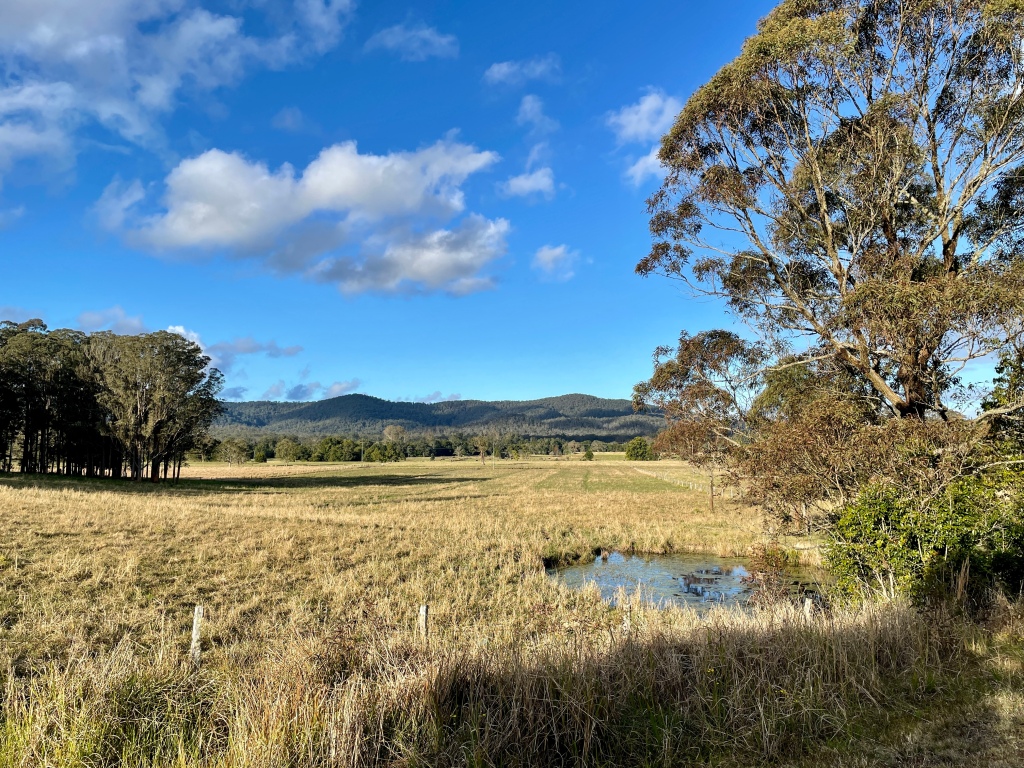
Having recently been subjected to the flooding rains that hit the Mid North Coast, the gumboots we were instructed to bring with us were donned not long after arriving. Kit gave us a tour of their soggy five-acre creative haven, complete with a running creek. They have a collection of tiny houses, studios and multi-use structures…and Carol’s big, light-filled studio perched on the edge of a waterlily-covered dam at the far end of the block, views extending east to the range. I’ll admit I’m suffering a little studio envy after a delightful afternoon tea on the deck beside the dam.
Talk of our creative lives continued over a dinner of okonomiyaki and miso soup prepared by Kit. It was a perfect end to four days of exploring the Mid North Coast, it’s people and landscapes. There’s more yet to experience and learn, more sounds and people to record, and much more to consider in terms of what a post-carbon world might mean for regional NSW.
Stage 1 of Regional Futures is nearly at an end now with creative proposals due soon.
Other residency blog posts
Exploring regional creative collaboration, 5 June 2022
Whatever we do has impact, 20 June 2022
What the past tells us about our future, 28 June 2022

